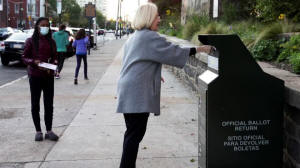Americans go to polls after tumultuous campaign marked by division,
coronavirus
 Send a link to a friend
Send a link to a friend
 [November 03, 2020]
By John Whitesides [November 03, 2020]
By John Whitesides
WASHINGTON (Reuters) - Americans headed to
the polls on Tuesday to decide whether incumbent Donald Trump or
challenger Joe Biden will be elected president, after a tumultuous four
years under the businessman-turned-politician that have left the country
as deeply polarized as at any time in its recent history.
Biden, the Democratic candidate and a career politician, has had a
strong and consistent lead in national polls.
But the Republican Trump is close in enough swing states to possibly
piece together the 270 state-by-state Electoral College votes needed to
hold on to the presidency, which he won in a surprise 2016 election
result despite losing the popular vote to Democrat Hillary Clinton by
nearly 3 million ballots.
However, it may be days before the result is known, especially if legal
challenges focused on postal ballots are accepted in the event of a
tight race.

There is also fear about possible unrest. Several cities are boarding up
buildings in anticipation of possible protests, including around the
White House and in New York City.
Polls opened in some Eastern states at 6 a.m. EST (1100 GMT). The most
closely watched results will start to trickle in after 7 p.m. EST (2400
GMT) when polls close in states such as Georgia, though definitive
national results could take days if the contest is tight.
The voting caps a campaign dominated by the coronavirus pandemic that
has killed more than 231,000 people in the United States and put
millions out of work. The country has also been shaken by nationwide
protests over racial injustice against Black Americans.
Biden, who has framed the contest as a referendum on Trump's handling of
the virus, promised a renewed effort to combat the health crisis, fix
the economy and bridge America's political divide.
Although more than 99 million Americans have already voted in early,
in-person voting or by mail, Election Day marks a deadline for votes to
be cast and still serves as a ritual for those who go to the polls on
the first Tuesday after the first Monday in November.
The early vote total, as reported by the U.S. Elections Project at the
University of Florida, set a record and underscored the intense interest
in the election and concerns about voting in person on Election Day
during a pandemic.

The number was equal to 72.3% of the entire turnout in 2016 and experts
predicted turnout would easily surpass the 138 million who voted in
2016.
The election has already prompted a wave of litigation over whether to
adjust voting rules in light of the COVID-19 pandemic. On Monday, a
federal judge in Texas rejected a Republican bid to throw out about
127,000 votes already cast at drive-through voting sites in the
Democratic-leaning Houston area.
Trump has questioned the integrity of the election results for months,
making unsubstantiated claims that mail-in voting is rife with fraud and
refusing to commit to a peaceful transfer of power if he loses.
Trump has also said votes should only be counted through election night,
even though many states often take days or weeks to tally ballots.
[to top of second column]
|

As a polarizing campaign that has shattered early voting records
comes to a close, Reuters Polling Editor Chris Kahn explains what
makes this presidential election unlike any other.

CONTROL OF CONGRESS AT STAKE
Voters on Tuesday will also decide which political party will
control the U.S. Congress for the next two years, with Democrats
pushing to recapture a Senate majority and expected to retain their
control of the House of Representatives.
Trump, 74, is seeking another four years in office after a
tumultuous first term marked by the coronavirus crisis, an economy
battered by pandemic shutdowns, an impeachment drama, inquiries into
Russian election interference, U.S. racial tensions and contentious
immigration policies.
Trump held five campaign rallies in four states on Monday, returning
to Washington at 2:35 a.m. Eastern time on Tuesday. Trump was
expected spend most of Tuesday at the White House, where an election
night party is planned for 400 guests, all of whom will be tested
for COVID-19.
Biden, 77, is looking to win the presidency after a political career
spanning five decades including eight years as vice president under
Trump's Democratic predecessor, Barack Obama. He mounted
unsuccessful bids for the Democratic presidential nomination in 1988
and 2008.

Biden spent his last full day of campaigning in the swing states of
Ohio and Pennsylvania, and was expected to spend Election Day in
Scranton, Pennsylvania, his childhood home, and Philadelphia.
The two candidates have focused on about a dozen competitive state
battlegrounds, nearly all states that Trump won in 2016.
Much of their attention has gone to Florida, with 29 electoral
votes. The state is seen as the biggest must-win for Trump, as a
loss there would block most of the president's viable paths to
winning the Electoral College.
Results in Florida, where mail-in ballots can be counted before
Election Day, are expected to begin to come in relatively quickly on
Tuesday night.
But Pennsylvania, Michigan and Wisconsin will not begin counting the
flood of mail ballots until Election Day, raising the possibility of
a prolonged vote count that could stretch for several days.
(Reporting by John Whitesides; Additional reporting by Steve Holland
and Daniel Trotta; Editing by Soyoung Kim and Angus MacSwan)
[© 2020 Thomson Reuters. All rights
reserved.] Copyright 2020 Reuters. All rights reserved. This material may not be published,
broadcast, rewritten or redistributed.
Thompson Reuters is solely responsible for this content.
 |